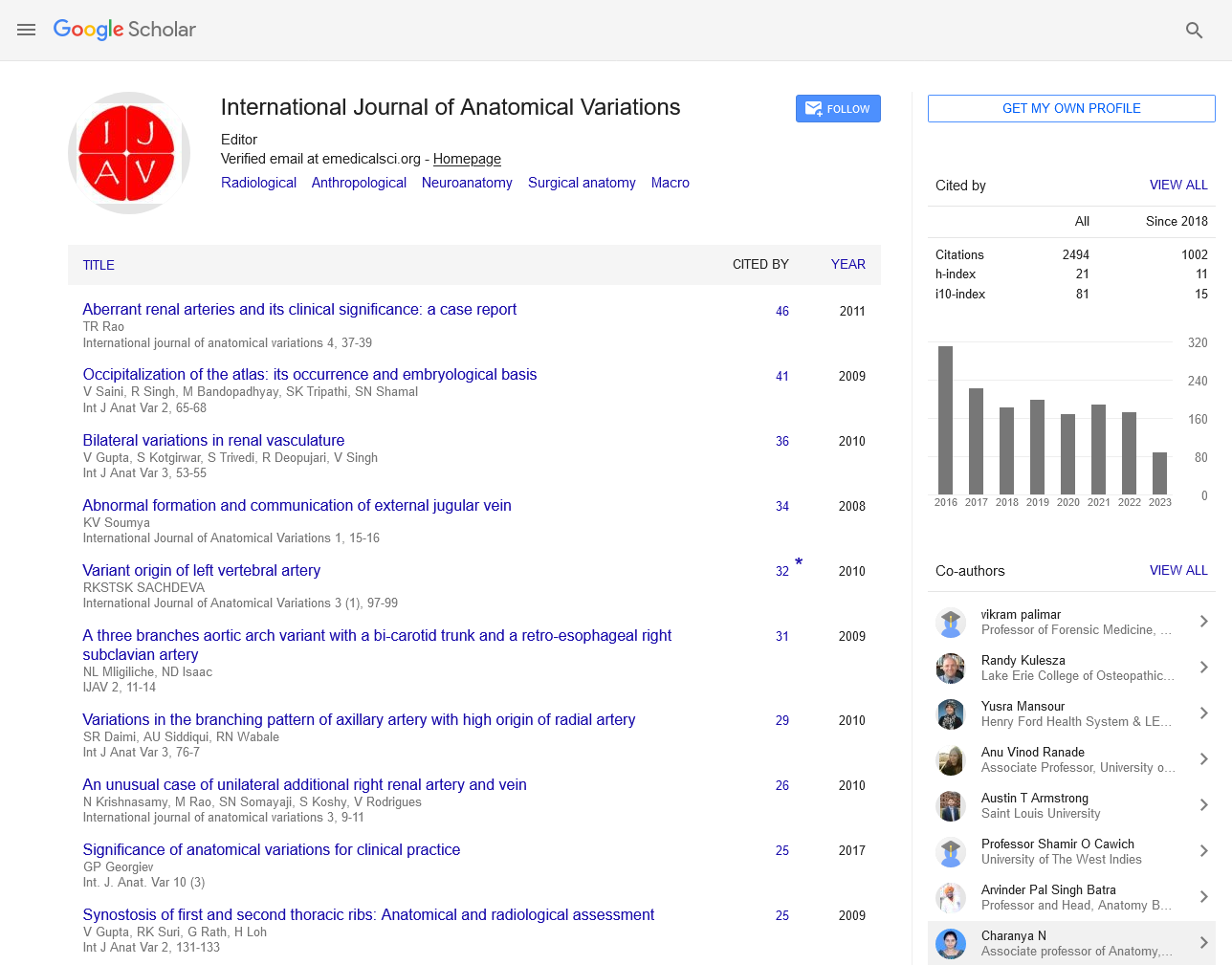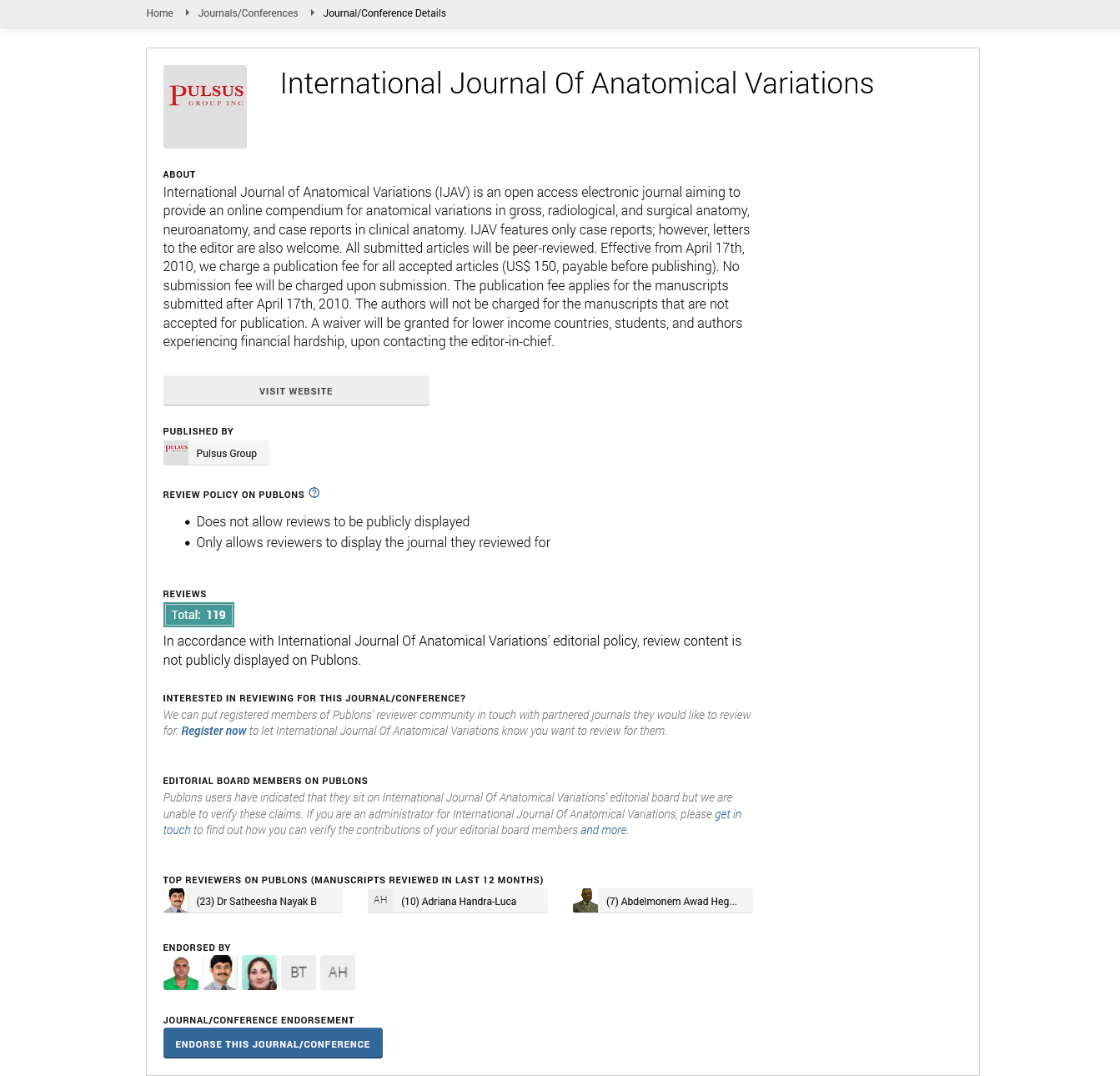Embryological Basis and Clinical Implications of Vascular and Nervous Anatomical Variations
Received: 01-Mar-2025, Manuscript No. ijav-25-7636; Editor assigned: 04-Mar-2025, Pre QC No. ijav-25-7636 (PQ); Reviewed: 19-Mar-2025 QC No. ijav-25-7636; Revised: 26-Mar-2025, Manuscript No. ijav-25-7636 (R); Published: 30-Mar-2025, DOI: 10.37532/1308 4038.18(3).494
Citation: Kumar A. Embryological Basis and Clinical Implications of Vascular and Nervous Anatomical Variations. Int J Anat Var. 2025; 18(3): 758-759.
This open-access article is distributed under the terms of the Creative Commons Attribution Non-Commercial License (CC BY-NC) (http://creativecommons.org/licenses/by-nc/4.0/), which permits reuse, distribution and reproduction of the article, provided that the original work is properly cited and the reuse is restricted to noncommercial purposes. For commercial reuse, contact reprints@pulsus.com
Abstract
Embryological development plays a fundamental role in shaping the vascular and nervous systems. Anatomical variations arising during development may influence surgical outcomes and diagnostic interpretation. This paper explores the embryological basis of vascular and neural anatomical variations and highlights their implications in clinical practice.
INTRODUCTION
Embryogenesis is a tightly regulated process that sometimes produces unexpected but benign anatomical structures. These developmental deviations can manifest as variations in arteries, veins, and nerves [1]. This article discusses how specific variations originate embryologically and their practical impact in medicine. The complexity and precision of human anatomy are products of intricate developmental processes that unfold during embryogenesis. While the classical anatomical descriptions form the foundation of medical education, the reality is that many individuals exhibit subtle to significant deviations from these norms—known as anatomical variations. These variations, particularly within the vascular and nervous systems, often originate during early embryological development as a result of altered regression, persistence, or transformation of embryonic structures. Vascular and neural anatomical variations are not rare; in fact, they are more common than often acknowledged. Their presence can be entirely asymptomatic, yet they hold immense clinical importance. Variations in arterial branching patterns [2], venous drainage, or neural pathways can significantly affect surgical planning, procedural outcomes, and diagnostic interpretations. For example, an aberrant subclavian artery or a persistent left superior vena cava may alter the hemodynamic landscape and complicate cardiothoracic surgeries. Similarly, early division of the sciatic nerve or a pre-fixed brachial plexus can influence the success of regional anesthesia or lead to unexpected intraoperative findings. Understanding the embryological basis behind these variations is not only essential for academic purposes but also for improving clinical competence. By tracing how normal developmental processes can diverge to form variant anatomical structures, clinicians are better equipped to anticipate, identify, and adapt to these deviations in practice. This review explores the developmental origins of common vascular and nervous system variations and highlights their practical significance in modern medicine. Through an integrated embryological and clinical perspective, the article aims to bridge the gap between theoretical anatomy and applied healthcare [3].
EMBRYOLOGICAL ORIGINS
The embryological development of the vascular and nervous systems is a highly orchestrated process that sets the foundation for anatomical structures observed in the adult body. During early development, the human embryo forms a basic network of vessels and neural structures that undergo extensive remodeling and differentiation. However, variations arise when there are deviations in the timing, patterns, or mechanisms of these processes. In the vascular system, most anatomical variations result from the persistence or abnormal regression of embryonic arteries. For example, the accessory renal artery occurs due to the persistence of one or more of the embryonic renal arteries that typically regress after the development of the definitive renal blood supply. Similarly, the aberrant right subclavian artery [4], a common variation in the aortic arch, arises when there is an abnormality in the regression of the right fourth aortic arch, leading to the right subclavian artery originating from the descending aorta rather than the brachiocephalic trunk. This variation can result in compression of the esophagus, leading to symptoms like dysphagia lusoria. In the case of persistent median artery, a vessel that typically regresses in the fetus, failure to do so leads to its persistence into adulthood. This is commonly encountered during carpal tunnel surgery and can pose a risk for bleeding or injury.
CLINICAL IMPLICATIONS
Awareness of vascular variants helps in transplant surgeries, vascular reconstruction, and tumor resection. CT/MRI may misinterpret a normal variant as pathological without anatomical knowledge. Variation in nerve position alters effectiveness and safety of blocks [5].
CASE STUDIES
A patient with triple renal arteries required tailored arterial anastomosis. Caused by a post-fixed plexus variant, verified intraoperatively.
DISCUSSION
Understanding the embryological basis aids clinicians in predicting and recognizing variations, especially when standard approaches fail. Incorporating such knowledge into training programs enhances diagnostic precision and procedural safety.
CONCLUSION
Anatomical variations, though non-pathological, are vital in clinical decision-making. An embryological approach deepens understanding and improves patient outcomes in surgical and radiological practice.
REFERENCES
- Mamikonyan VR, Pivin EA, Krakhmaleva DA. Mechanisms of corneal neovascularization and modern options for its suppression. Vestn Oftalmo. 2016; 132(4):81-87.
- Gaigalaite V, Dementaviciene J, Vilimas A, Kalibatiene D. Association between the posterior part of the circle of Willis and vertebral artery hypoplasia. PLoS ONE. 2019; 14(9): e0213-226.
- Anri S, Masayoshi O, Shigeru H. Glomerular Neovascularization in Nondiabetic Renal Allograft Is Associated with Calcineurin Inhibitor Toxicity. Nephron. 2020; 144 Suppl 1:37-42.
- Mujagic S, Kozic D, Huseinagic H, Smajlovic D. Symmetry, asymmetry and hypoplasia of intracranial internal carotid artery on magnetic resonance angiography. Acta Med Acad. 2016; 45:1- 9.
- Rusu MC, Vrapclu AD, Lazar M. A rare variant of accessory cerebral artery. Surg Radiol Anat. 2023; 45(5):523-526.
Indexed at, Google Scholar, Crossref
Indexed at, Google Scholar, Crossref
Indexed at, Google Scholar, Crossref
Indexed at, Google Scholar, Crossref






